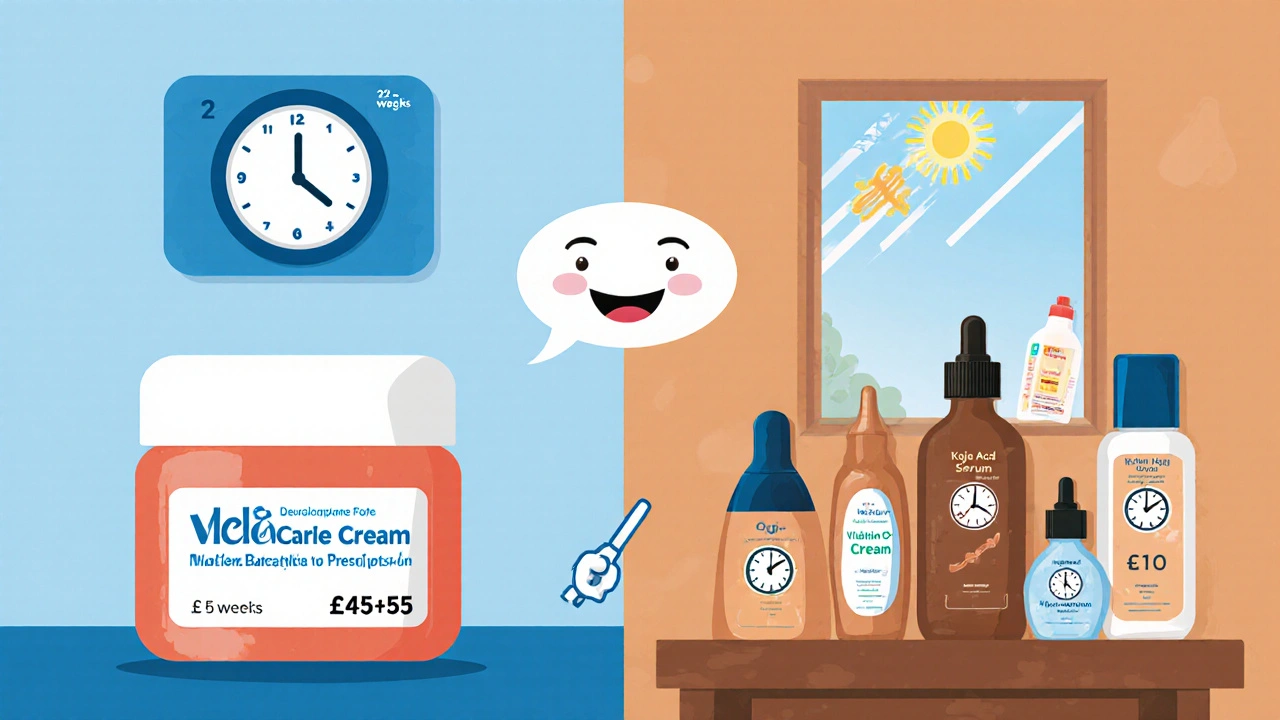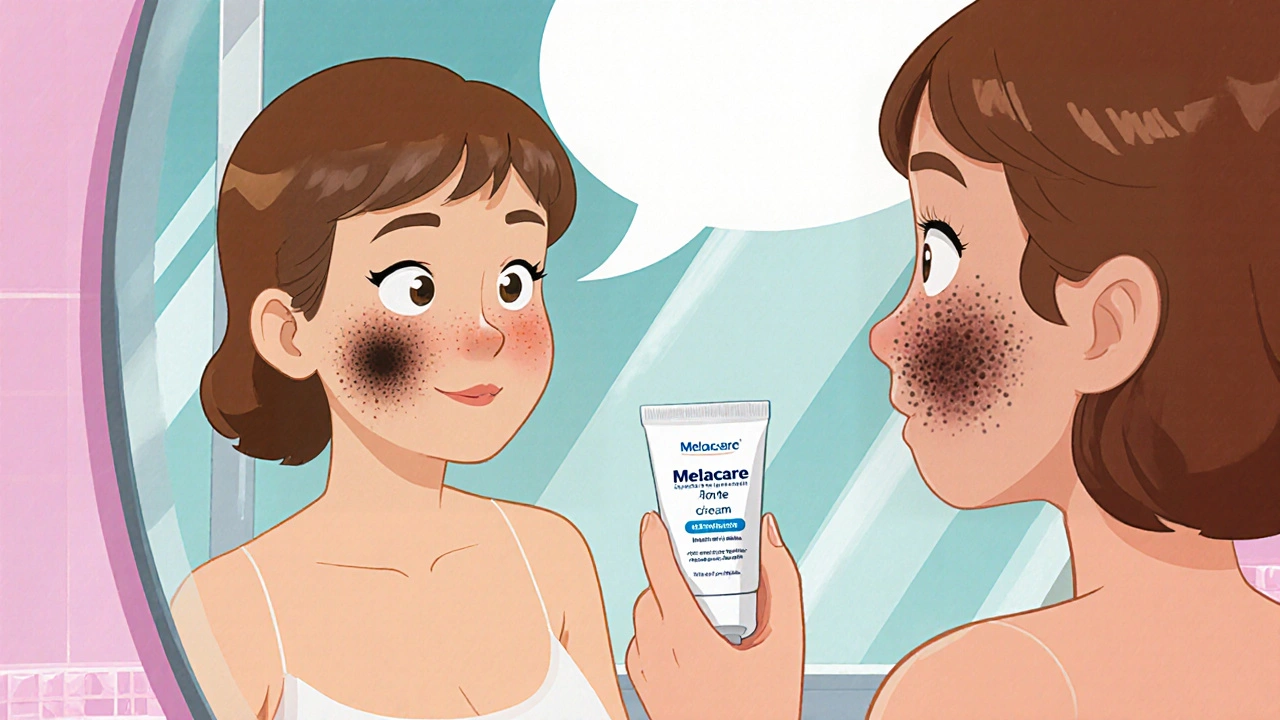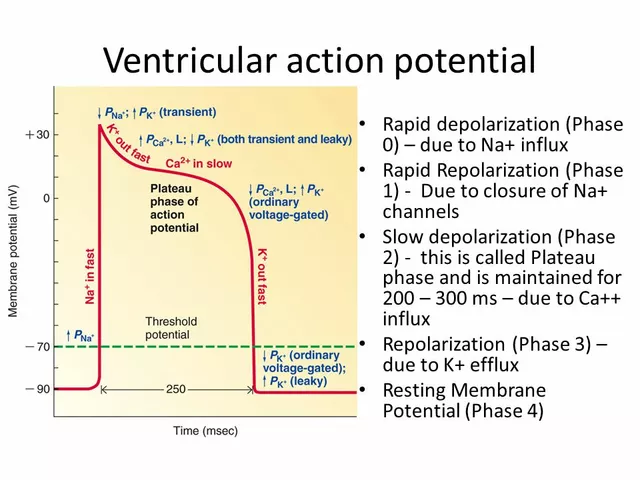If you’ve been hunting for a fast‑acting melasma solution, Melacare Forte Cream often pops up in forums. It combines three powerful actives-hydroquinone, mometasone and tretinoin-into a single prescription‑only tube. While the blend promises rapid fading of stubborn dark patches, many people wonder whether it’s worth the prescription hassle or if over‑the‑counter alternatives can do the job safely.
When we talk about Melacare Forte Cream is a prescription‑strength topical formulated to treat melasma, post‑inflammatory hyperpigmentation and other stubborn discolorations. It contains 4% hydroquinone, 0.1% mometasone (a mild corticosteroid) and 0.05% tretinoin (a retinoid), each targeting melanin production, inflammation and skin turnover. Understanding how each component works helps you decide if the combo is right for you.
How the Three Actives Work Together
- Hydroquinone is a phenolic compound that inhibits tyrosinase, the enzyme responsible for melanin synthesis. By reducing melanin production, it lightens existing dark spots.
- Mometasone is a low‑potency corticosteroid that calms inflammation and prevents the skin from reacting to the irritant effects of hydroquinone.
- Tretinoin is a retinoid that accelerates cell turnover, helping shed pigmented cells faster and improving overall skin texture.
The trio is designed to give a faster, more pronounced result than a single‑ingredient cream. However, the blend also raises the risk of irritation, steroid‑related side effects, and the need for dermatologist supervision.
Key Criteria for Comparing Skin‑Lightening Creams
Before we stack alternatives against Melacare, let’s agree on the factors that matter most to most users:
- Active ingredient strength - How potent is the melanin‑blocking agent?
- Safety profile - Risks of irritation, allergic reactions, or long‑term complications.
- Prescription requirement - Do you need a doctor’s go‑ahead?
- Cost per month - Average price for a 30‑day supply.
- Speed of results - Typical weeks to see noticeable lightening.
- Additional skin benefits - Does it address texture, redness, or acne?
Popular Over‑the‑Counter Alternatives
Below are four widely available products that many users try before or instead of a prescription blend.
Azelaic Acid is a dicarboxylic acid that both inhibits tyrosinase and has anti‑inflammatory properties, making it a gentle brightening agent. Typical over‑the‑counter concentrations range from 10% to 20%.
Kojic Acid derives from fermented rice and works by chelating copper ions needed for melanin synthesis. It’s often found in serums at 1%‑4% strengths.
Vitamin C (L‑ascorbic acid) is an antioxidant that reduces melanin formation and brightens skin tone. Serums typically contain 10%‑20% vitamin C.
Niacinamide (Vitamin B3) reduces transfer of melanosomes to skin cells and improves barrier function. Creams often have 4%‑5% niacinamide.

Side‑by‑Side Comparison Table
| Product | Key Active(s) | Typical Strength | Prescription? | Result Speed | Common Side Effects | Avg Monthly Cost (UK) |
|---|---|---|---|---|---|---|
| Melacare Forte Cream | Hydroquinone, Mometasone, Tretinoin | 4% / 0.1% / 0.05% | Yes | 2‑4 weeks | Redness, dryness, steroid‑related thinning | £45‑£55 |
| Azelaic Acid Cream | Azelaic Acid | 10‑20% | No | 4‑6 weeks | Mild tingling, dryness | £20‑£30 |
| Kojic Acid Serum | Kojic Acid | 1‑4% | No | 6‑8 weeks | Potential irritation, rare allergic reaction | £15‑£25 |
| Vitamin C Serum | L‑Ascorbic Acid | 10‑20% | No | 4‑8 weeks | Stinging, oxidation if not stored properly | £25‑£40 |
| Niacinamide Cream | Niacinamide | 4‑5% | No | 6‑10 weeks | Rare flushing | £18‑£28 |
When to Choose Melacare Forte Cream
Given the data above, Melacare shines in three scenarios:
- Severe melasma or stubborn post‑inflammatory hyperpigmentation that hasn’t responded to milder agents.
- Need for rapid improvement-patients often report visible lightening within two weeks.
- Professional oversight is available-a dermatologist can monitor side effects, adjust usage frequency, and taper the steroid component.
If you’re comfortable with a prescription, can attend follow‑up visits, and want the quickest fade, the three‑in‑one formula is hard to beat.

When OTC Alternatives Might Be Better
Choose an over‑the‑counter product if any of these apply:
- You have sensitive skin or a history of steroid‑induced thinning.
- Cost is a major concern; the OTC options stay under £30 a month.
- You prefer a gradual approach with lower irritation risk.
- You’re treating mild hyperpigmentation rather than deep melasma.
Many dermatologists actually start patients on an OTC agent, then step up to a prescription like Melacare only if the lighter regimen stalls.
Safety, Regulation, and Real‑World Tips
In the UK, hydroquinone over 2% requires a prescription, and the combination with a corticosteroid and retinoid is classified as a “Specials” product, meaning it can only be dispensed by a licensed pharmacist after a doctor’s script. This regulatory gate helps limit misuse but also adds a cost and a wait.
For OTC choices, look for products that are cosmetic‑grade (i.e., formulated without animal testing, with stable packaging) and that list the exact concentration of the active. A common pitfall is buying “generic” kojic acid creams that claim 10% strength but actually contain far less.
Practical tips:
- Patch test every new product on the inner forearm for 48 hours.
- Apply at night and follow with a broad‑spectrum SPF 30+ sunscreen the next day; any lightening agent makes skin UV‑sensitive.
- Start with two evenings a week, then gradually increase to nightly use if tolerance allows.
- Keep a simple log: date, product, amount, any redness. This helps your dermatologist spot trends quickly.
Bottom Line: What Should You Pick?
If you need a fast, clinically proven fade and you have a dermatologist willing to monitor you, Melacare Forte Cream remains the heavyweight champ for severe melasma. For most people with mild to moderate discoloration, a well‑formulated azelaic acid or vitamin C serum offers a safer, cheaper, and easy‑to‑access route.
Remember, the best regimen often mixes more than one ingredient-e.g., using a nightly vitamin C serum for antioxidant protection while reserving a short course of Melacare for the stubborn spots. Consistency, sun protection, and realistic expectations are the real secret sauce.
Is Melacare Forte Cream safe for long‑term use?
Because it contains a corticosteroid (mometasone) and a retinoid (tretinoin), most dermatologists limit continuous use to 8‑12 weeks, then advise a break or a tapering schedule to avoid skin thinning or irritation.
Can I use a sunscreen with Melacare?
Absolutely. In fact, sunscreen is mandatory because hydroquinone and tretinoin increase photosensitivity. A broad‑spectrum SPF 30+ applied every morning protects results.
How does azelaic acid compare to hydroquinone?
Azelaic acid is gentler and works both as a melanin‑inhibitor and an anti‑inflammatory agent. It’s slower-usually 4‑6 weeks for visible change-but carries a much lower risk of irritation and has no prescription barrier.
Do OTC vitamin C serums really brighten skin?
Yes, especially at 15%‑20% concentrations, vitamin C blocks melanin formation and adds antioxidant protection. Results are subtle and take 6‑8 weeks, but the serum also improves overall radiance.
What should I do if I experience redness with Melacare?
Stop using the cream for a few days, apply a soothing moisturizer (e.g., ceramide‑rich), and contact your dermatologist. They may lower the application frequency or replace mometasone with a milder steroid.







14 Comments
Melacare is overhyped; the steroid alone does more harm than good.
Listen, the American market loves to sell snake‑oil wrapped in a fancy prescription. You think a three‑in‑one cream is some miracle? It’s a cocktail of irritants that will leave you needing a dermatologist anyway. The real problem is the hype that people chase without reading the fine print. Stop buying hype and start demanding transparency.
Ah, the grand theater of dermatological commerce, where hydroquinone is crowned king and steroids bow in subservience. One might argue that the concoction is nothing more than a metaphor for modern society: a triad of ambition, control, and decay. The active ingredients, each a masterpiece of chemistry, are thrust together like misguided philosophers at a dinner party. Hydroquinone claims to rewrite the very genetics of melanin, while mometasone whispers promises of calm, and tretinoin shouts for renewal. Yet, the reality is a battlefield where the skin is the unfortunate casualty. The speed of pigment fading is impressive on paper, but the collateral damage to the epidermal barrier is rarely highlighted. Patients often experience a paradox: lighter spots but a more sensitive, flaky canvas. The steroid component, though low‑potency, can precipitate subtle thinning if used unchecked for months. Tretinoin, while a champion of cell turnover, also accelerates barrier loss, making the skin a porous gateway for irritants. When the three agents are combined, the synergy is less about harmony and more about a volatile chemical ménage à trois. Dermatologists caution that such regimens should be time‑limited, yet marketing material glosses over this nuance. In practice, many users self‑extend usage, chasing diminishing returns while accumulating risk. The underlying truth is simple: faster results often carry a higher price in skin health. Therefore, the prescription blend is a double‑edged sword, wielded best under professional supervision. Ultimately, the decision rests on whether you value rapid aesthetic gain over long‑term dermal integrity.
Oh, please! If the “philosophers” of skincare think you need a prescription for every blemish, they’re just feeding the industry's ego. I’ve seen people with mild hyperpigmentation ruin their complexion chasing the next “miracle” invention. Real results come from consistency, not from a cocktail that feels like a chemical experiment. The drama around melasma is inflated, and the truth lies in humble, patient care.
Statistically, the prescription blend shows a 30‑40% faster reduction in melasma scores compared to azelaic acid alone, but the confidence interval widens when side‑effects are factored in. Users report a higher incidence of erythema and barrier disruption, which can offset the speed advantage. Therefore, the decision matrix should weigh rapidity against long‑term skin health. A phased approach-starting with gentler actives and escalating only if necessary-optimizes outcomes while minimizing risk.
i dont know why ppl keep thinkin melacare is the only way to fix dark spots lol its just another chem that can mess ur skin up if u dont watch out. the steroid part can make ya skin thin real fast if u use it nonstop. plus the cost is kinda crazy for what it is, especially when you can get decent over‑the‑counter stuff for half the price. just make sure u do a patch test first, trust me.
Honestly, I could write a dissertation on how the hype machine works, but I’ll settle for saying: if you’re saving pennies, stick with the OTC options. The “specials” label is just a marketing ploy to keep you locked in a cycle of doctor visits.
Hey folks! 🌟 If you’re new to the world of skin‑brightening, start simple: a gentle cleanser, sunscreen every morning, and a stable vitamin C serum can do wonders. 🌞 Remember, consistency beats intensity – you don’t need to jump straight into a prescription unless a dermatologist says it’s necessary. 👍 Feel free to share your routine, and we’ll help fine‑tune it together! 💬
I hear you – dealing with melasma can feel like a never‑ending battle, especially when irritation shows up. It’s okay to pause and give your skin a breather; soothing moisturizers with ceramides can restore the barrier. Keep a diary of what you apply and how your skin reacts; it’s a small step that makes a big difference in the long run.
TL;DR: The formulation is a high‑risk, high‑reward paradigm, leveraging melanogenic inhibition (hydroquinone) alongside anti‑inflammatory (mometasone) and keratolytic (tretinoin) vectors. 🚀 If you’re not adept at managing iatrogenic dermatitis, the adverse event profile outweighs the incremental luminous gain. 🤔
Stay hopeful – gradual, steady improvement is still progress, and protecting your skin with SPF is the best investment you can make.
Don’t be fooled – the push for prescription melasma creams is part of a larger agenda to keep you dependent on pharma giants. They want you to believe only “big‑lab” products work, while they hide cheaper, natural alternatives that could be just as effective. Wake up and question the narrative.
Here’s a quick cheat sheet for anyone feeling overwhelmed: first do a patch test then start with a low concentration azelaic acid apply at night follow with a moisturizer use sunscreen daily re‑evaluate after 4 weeks if no irritation consider stepping up to a higher strength or consult a dermatologist if needed
Patriot skin care means rejecting foreign prescription scams.